Transform Your Yard: Top Austin, TX Landscaping Ideas for Stunning Outdoor Spaces

Feb 21, 2024
A desirable garden is more than just a collection of plants. It’s a living, breathing manifestation of your personal style, a testament to your connection with nature, and a haven to retreat to. But how do you create a garden that’s not only stunning but also low-maintenance and eco-friendly? Especially in Austin, TX, where the climate presents its unique challenges. Well, that’s exactly what we’ll explore today with Austin, TX landscaping ideas. So buckle up as we take a journey through transforming your yard with a blend of science, art, and a dash of creativity.
Key Takeaways
- Xeriscaping with drought-tolerant plants and shade solutions like pergolas and native trees is optimal for Austin’s climate, conserving water and protecting plants while adding aesthetic appeal.
- Landscaping with native plants, smart mulching, and low-maintenance lawn choices like clover lawn can create a low-maintenance oasis that reduces water and upkeep requirements.
- Water-saving landscaping strategies, such as efficient irrigation systems, xeriscaped areas, and rain gardens, can stylishly conserve water and enhance the functionality and beauty of Austin gardens.
Embracing Austin’s Climate in Your Garden Design
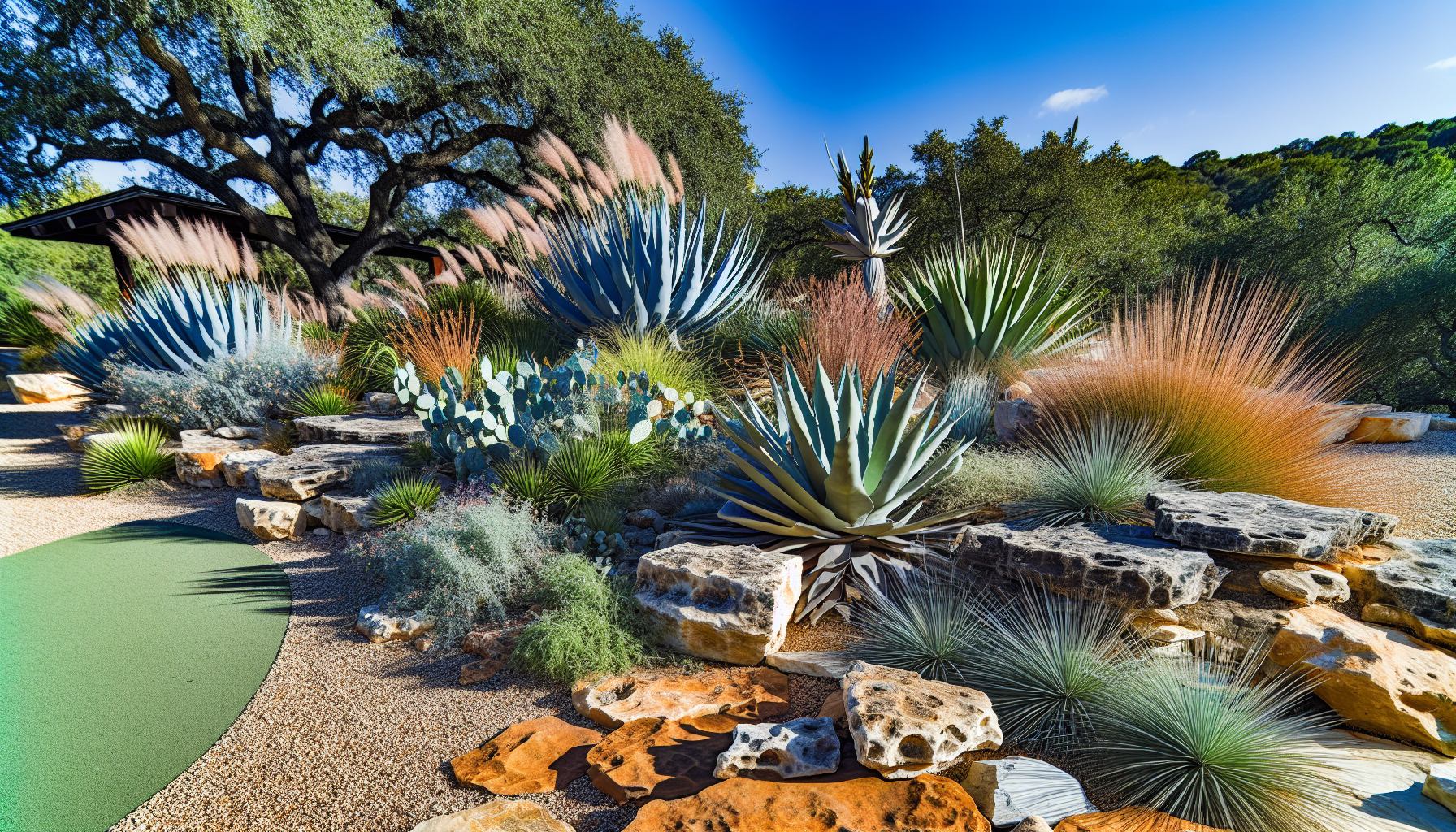
In Austin, the hot summers and unpredictable weather necessitate a unique approach to gardening. This is where xeriscaping enters. It’s an eco-friendly landscaping style that uses drought-tolerant plants and minimizes watering needs while still allowing for stunning gardens. Xeriscapes conserve both water AND time by avoiding lawn mowing as well as fertilizing processes!
To ensure your garden flourishes in the heat, incorporate shade with structures like pergolas or trees/large shrubs so all sorts of plants can thrive, essentially working together with Austin’s climate instead of against it. This way, you’ll create a lush outdoor living area designed specifically for its distinctive character here in Texas’ capital city.
Selecting Drought-Tolerant Plants
Landscaping in Austin can be made much more drought-resistant by choosing the right plants. Ornamental grasses and bearded irises are excellent examples of water-wise flora that require little care, making them perfect for low-maintenance gardening projects. Adding organic mulch to these kinds of vegetation helps maintain moisture levels while keeping weeds down, ultimately decreasing any upkeep demands for your garden or yard. The climate there makes it necessary to invest some thought into what greenery is included, but with a bit of preparation, you’ll have an effortlessly resilient landscape!
Incorporating Shade Solutions
For many plants in the Austin region, shade can be a matter of life and death. To make outdoor spaces more hospitable and protect your vegetation from too much sun exposure, consider building pergolas or planting trees such as Mexican Sycamore, Monterrey Oak, or Red Oak that offer beautiful foliage along with ample amounts of shading. Large shrubs like Leucophyllum frutescens or Mahonia trifoliolata are attractive options for providing some shelter to different areas in your yard while adapting well to this climate.
Planning for Weather Variability
When dealing with Austin’s ever-changing weather, making a plan to accommodate these changes is imperative. For successful gardening, using native plants that are adapted to handle rain and other conditions can be beneficial. During heavy rainfall times, it may help planting in cooler months or utilizing trees for shade as well as soaker hoses for adequate watering techniques which will keep your garden flourishing throughout such periods of wetness.
Crafting a Low Maintenance Oasis
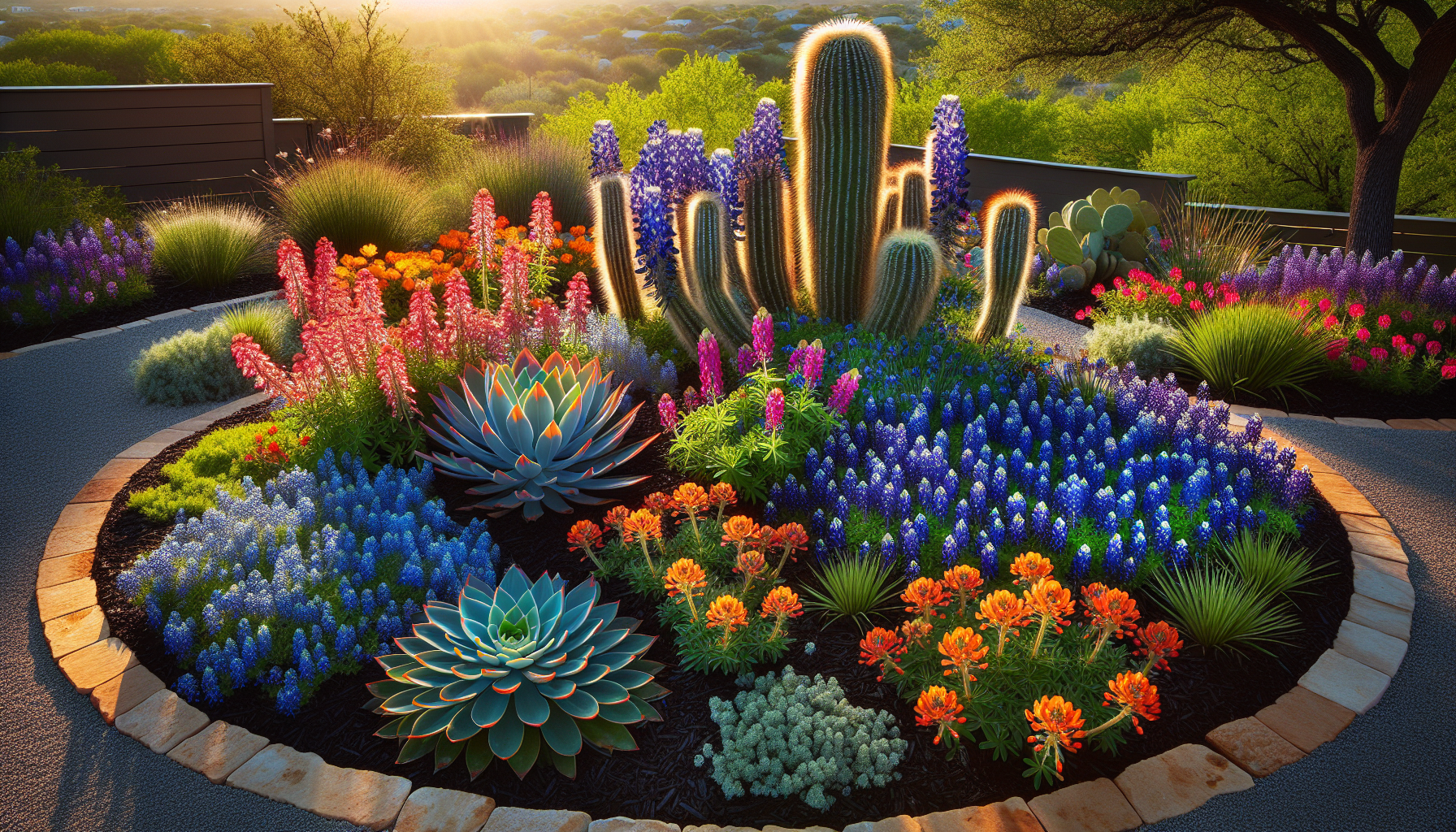
Creating a garden that is not only eye-catching but low in maintenance as well can be achieved. Low-maintenance landscaping includes prioritizing native flora, using sensible mulching techniques, and simplifying lawn care with cost-effective ideas. We are going to provide you with some tips for your own dream garden that needs minimal attention while still maintaining its beauty.
For instance, plants such as Little Bluestem, Rockrose, and Texas Sage require less water or fertilizer, thus making it the most efficient choice if you want a hardy yard without much effort put into upkeep annually. Applying mulch aids in preserving soil temperature, retaining moisture, & eliminating weeds, hence cutting back on watering necessities and reducing time spent on gardening projects significantly. Lastly, picking up drought-tolerant grass like clover instead of traditional ones will help minimize expenses associated with maintenance needed throughout the year, plus save labor too!
Prioritizing Native Flora
Native plants are a valuable asset for any Austin garden, helping conserve water and saving time due to their resilience in local climate conditions. They also contribute to biodiversity by providing habitats and food sources for native wildlife while reducing the use of insecticides or herbicides. Common plant choices that fit into this category include Rock Rose, Gregg’s Mistflower, Texas Wisteria, and Desert Willow, which can be incorporated with minimal effort into existing gardens!
Smart Mulching Techniques
Adding a layer of mulch between 2 and 3 inches thick can be the perfect way to improve your garden. It helps retain soil moisture, prevents erosion, and encourages faster absorption of water for plants in Austin gardens, especially cedar or juniperous asheri varieties. It inhibits weed growth while maintaining a neat appearance year-round; just remember to replace your mulch annually!
Streamlining Lawn Care
Maintaining a beautiful lawn in the climate of Austin can be made easier with careful strategizing. The local grasses, such as Bermudagrass, Zoysiagrass, St. Augustinegrass, and Ryegrass, are known to require minimal upkeep while being resistant to dry conditions, both of which are perfect for this area’s environment. To keep your lawn healthy, it is advised that you mow regularly while alternating directions every once in a while. When watering your turf, there should only be one session per week. Any more could lead to excessiveness, which would negatively compromise its health over time. With these strategies used together, you will have no trouble keeping hold of luscious green conditions on a low-maintenance basis throughout all seasons!
Water-Saving Strategies with Style
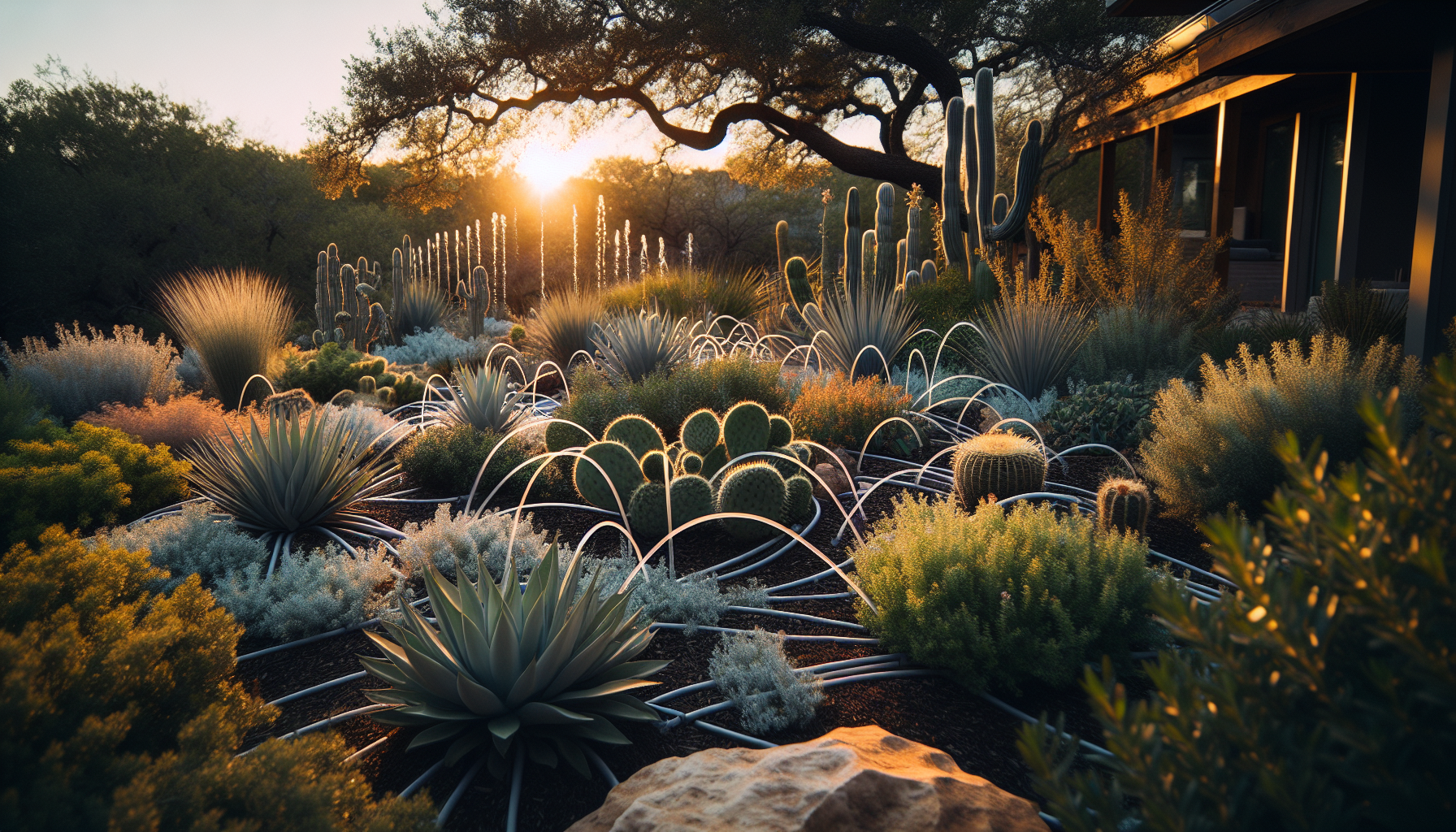
Conserving water is vital for any garden, and there’s no need to sacrifice looks. A well-planned space can look beautiful while also saving H2O through efficient irrigation techniques, xeriscaping features, and eye-catching rain gardens. These strategies conserve precious resources without compromising style, a win for both beauty and sustainability!
Installing Efficient Irrigation
An efficient automatic watering system is necessary for any water-conscious garden. There are numerous alternatives available, ranging from microspreaders to drip irrigation systems. In dry regions like Austin, this kind of technique has plenty of advantages: it cuts down on evaporation and delivers the right amount of moisture directly to plant roots as well as soil, meaning there’s a low level of nutrient loss in the ground. It also allows you to pinpoint specific sections or flowers if desired with ease because they can be placed aboveground or buried underground while being adjustable according to installation, which will make these mechanisms even more effective.
The bottom line when using such technologies for your particular garden is that proper installation should not be overlooked!
Creating Xeriscaped Areas
Xeriscaping involves developing a garden that requires little irrigation and is filled with drought-resistant plants, such as Texas Sage, Winecup Flower, or Prairie Verbena. To increase the attractiveness of your xeric setup, think about including decorative rocks to create an attractive scenery without needing too much water.
It is important to understand that there does not need to be any lack of color when making this type of landscape, but rather to create it in a way that limits watering requirements while preserving beauty at the same time!
Building Attractive Rain Gardens
Constructing a rain garden is an effective way to reduce the need for mowing, fertilizers, or chemicals while providing aesthetic appeal and functionality. Building this kind of outdoor space involves creating swales in order to channel gutter runoff, finding sites that have good water absorption capacity, determining the size/shape it by removing grass, and excavating the area before finally planting native species into it as part of its mix. This will attract pollinators, promoting biodiversity, which can also filter out pollutants from waterways, aiding in preserving our environment through increased water conservation.
The Art of Landscape Zoning
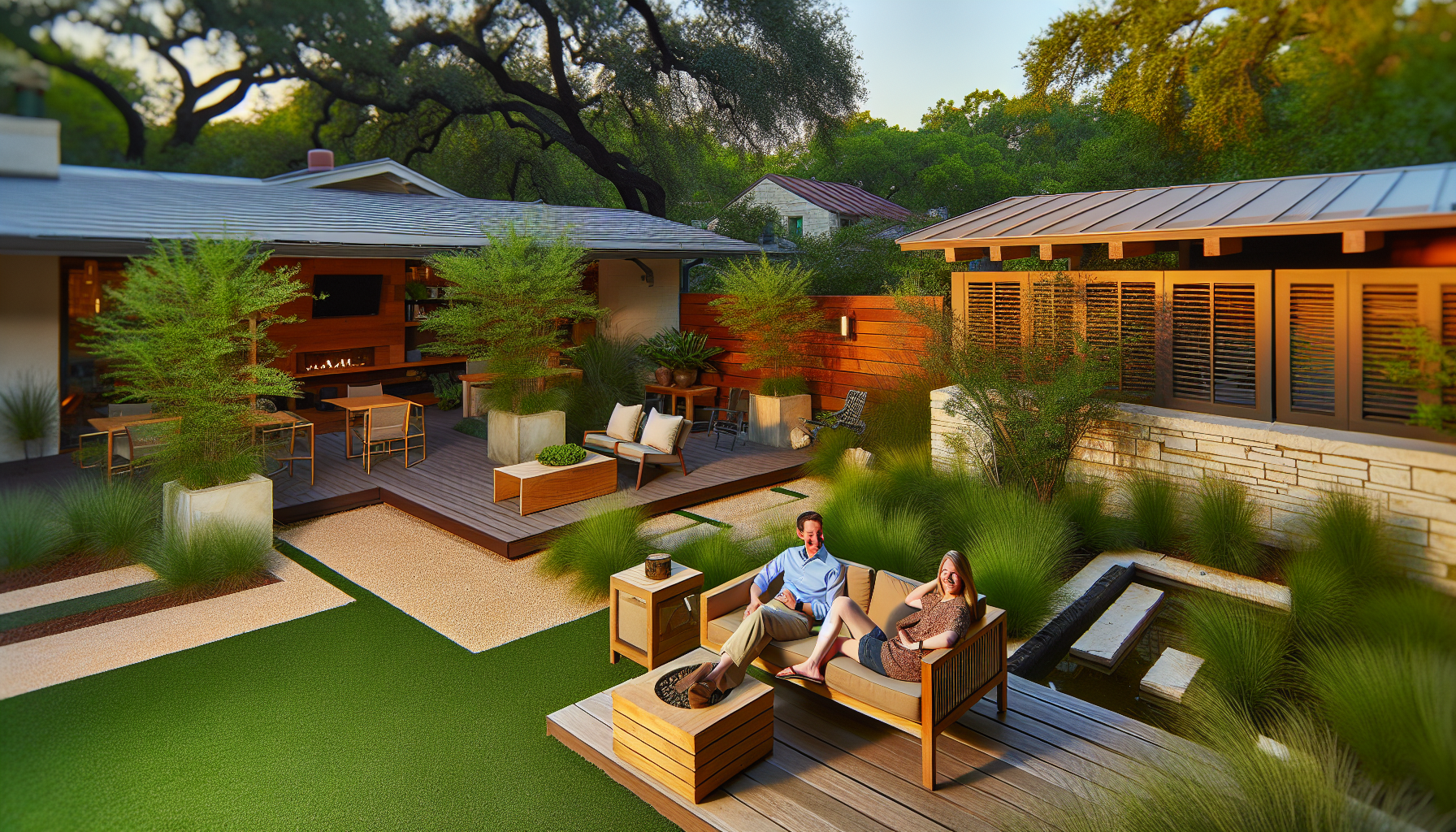
When it comes to landscape zoning, you can define particular areas in your garden that are appropriate for various activities. This way, not only will practicality and beauty be balanced, but also greenery with hardscapes. In order to achieve this effect successfully while making the garden more functional at the same time, careful planning should go into creating these spaces—whether it’s an outdoor living area or simply planting flower beds! Making sure each is properly designed according to its purpose yields amazing results, both visually as well as practically.
Defining Functional Spaces
Organizing your garden can be made easier by creating functional spaces that serve a purpose. Such areas, like providing shade or even hosting outdoor activities and entertaining guests, add structure and order to the backyard. For example, an outdoor room is similar to its counterpart inside the home – it’s just situated in another part of the property with designated purposes such as cooking/dining al fresco or simply soaking up some sun on comfy furniture for leisurely lounging sessions!
With this helpful addition come potential zones specifically tailored to different desires. Gardening enthusiasts may appreciate having their own private workspace, while families will love carving out plenty of space outdoors meant exclusively for recreational gaming experiences together. This strategic system ultimately helps streamline every activity taking place within one contained area!
Balancing Beauty and Practicality
A garden should not only be aesthetically pleasing but also practical. Utilizing perennials is a smart choice to reduce upkeep, and they offer an array of colors for decoration too. Employing mulch or gravel instead of more labor-intensive options creates beauty while still being cost-effective and requiring less maintenance work in the long run. Gardening this way permits homeowners to have a vibrant environment that doesn’t require lots of manual effort on their part throughout its lifespan.
Blending Hardscapes with Greenery
Creating balance in a garden design can be achieved through careful planning and the integration of hardscape elements, such as patios and walkways, with softscaping components like trees, plants, and flowers. In Austin’s landscape designs, this method is used to ensure that both living (plants) and non-living (hardscapes) aspects are represented in an aesthetically pleasing way. This approach helps bring harmony between nature’s bounty and man-made structures, creating a beautiful environment full of depth for one to enjoy.
Unique Features to Elevate Your Austin Landscape
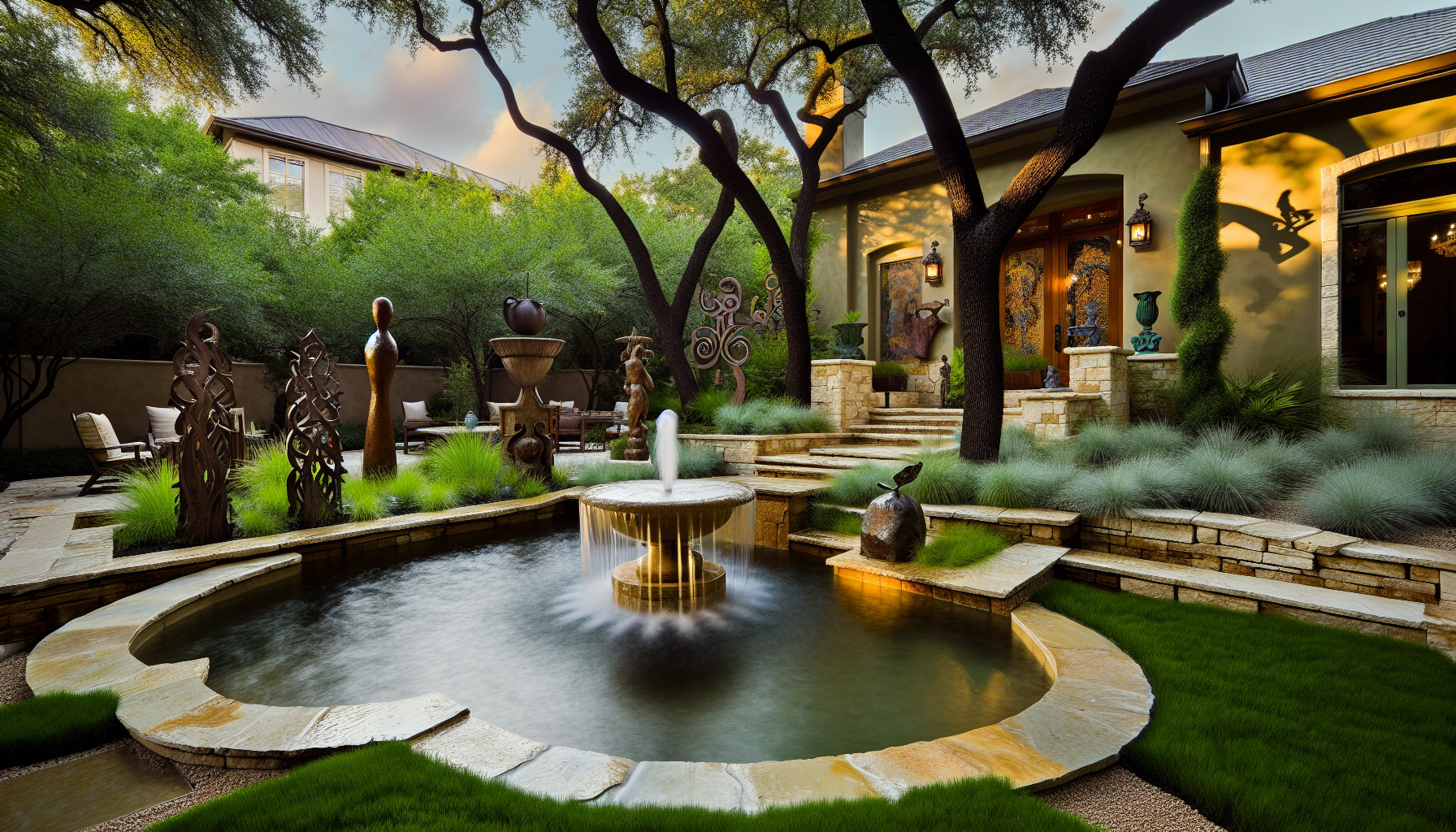
In Austin, a landscape can be made truly special with the addition of unique features such as water fixtures and artwork. A fire pit or outdoor fireplace could add charm to your garden while providing extra practical advantages like drawing in wildlife or making use of the yard even when it’s cold outside.
Adding a Water Feature
A water feature, such as a fountain or pond, can craft an enchanting and serene focal point in your garden that will also appeal to wildlife. As you choose the right one for your landscape, it’s important to think carefully about its location and ensure it complements the overall style of the environment. There are numerous varieties available, so select something that is aesthetically pleasing yet serves its purpose by being visible as well as calming.
Integrating Artistic Elements
In Austin, art is an integral part of the city’s landscape and can be effortlessly integrated into your garden for a unique touch. From sculptures to murals found in parks around town, add pieces that represent you aesthetically or fit within the scope of your existing outdoor space, such as introducing a rock garden if it captures your fancy. Art and gardens go hand-in-glove. Use them both for a one-of-a-kind look!
Designing with Fire Pits and Outdoor Fireplaces
A fire pit or outdoor fireplace can be a wonderful addition to any garden, creating an intimate space for family and friends all year round. When selecting the materials, consider those that are robust enough to manage Austin’s climate, like brick, stone, or concrete. To ensure your fire pit is both safe and optimally located for views of your garden, choose a spot in the yard that offers convenient access as well as picturesque sights.
Seasonal Splendor: Choosing Year-Round Plants
Having a garden that is attractive all year requires choosing plants suited to Austin’s climate and planning carefully. To get an array of flowers to bloom from spring through winter, it’s essential to select vegetation that will thrive in the local environment as well as add texture and colour with each season. By having vibrant flower beds throughout your garden, you can enjoy blooms not only during the summer but also when the colder months come around.
Spring and Summer Blooms
When the heat of Austin, Texas, arrives in the summer, your garden will be a vibrant and lively sight. Plants such as bluebonnet flowers, pink penta butterflies, winecup blooms, Prairie verbena, and lantanas with Gregg’s mistflower can really bring out their beauty! With proper care from you, though, it is possible to extend their bloom into even hotter months. An attractive oasis full of charm awaits all those who tend to these plants—guaranteed satisfaction for any green-thumbed individual!
Fall and Winter Interest
The gardening season doesn’t have to come to a halt when the days start getting shorter and cooler. In Austin, plants such as Juniper, Coralberry, Sumac, and Wax Myrtle thrive in this winter weather while giving an extra appeal with their berry seeds that provide food for wildlife. Native Texas peppers can bring color during these cooler months too! So don’t let colder temperatures stop you from taking care of your garden, make sure it shines throughout the year!
Maximizing Small Spaces for Big Impact
You can make the most of your limited yard space by getting creative with it and building a garden that seems more expansive than its actual size. By using strategies such as vertical gardening, container growing, or employing clever designs, you can craft an area in which to relax and feel at ease.
Vertical Gardening Techniques
Installing a trellis is an easy way to create the perfect vertical garden in your yard. Vertical gardening offers plenty of space-saving potential, where plants grow upwards instead of outwards for maximum effect. Ways you can make this happen include utilizing structures like fences and trellises as well as stacking or mounting containers on walls to really bring life into any small area with adult-size plantings. With just some planning involved, it’s effortless to create the lush display you desire from your home outdoors!
Container Gardening Tips
Those who live in Central Texas, especially in the city of Austin, can enjoy a space-efficient container garden. Various plants, such as Damianita Chrysactinia mexicana and Agave, Aloe Vera and Marigolds, Begonias or Chrysanths, and Fuschia geraniums, could be easily grown in pots or planters, which makes it easy to reorganize your landscape depending on changing sunlight conditions.
Container gardening offers an incredible variety for growing plenty of herbs like Thyme, Oregano, Cilantro, Lavender, and Zinnias that would normally fit well within small yards located around Austin, Texas.
Clever Layouts for Cozy Yards
Your yard can become an inviting and functional space with the right design approach. By applying principles such as balance, focus, and unity to your layout, you can build distinctive sections that make full use of the area available while adding visual appeal. The addition of layers to vegetation is a great way to provide depth, which will give off the impression of more room.
Furniture or planters on wheels will help make sure you are able to adjust for various activities like gardening or doing other work around your garden when needed without diminishing its charm – giving it credit where it’s due!
Summary
Creating an aesthetically pleasing and easy-to-maintain garden in Austin, Texas requires knowledge of the local climate, selecting plants wisely, as well as utilizing clever design approaches. Take advantage of these unique regional conditions to craft a beautiful yet sustainable sanctuary. From xeriscaping techniques to adding shade solutions for efficient irrigation or native flora and creative features, small yards can be transformed into your own personal oasis with careful planning!
Frequently Asked Questions
How do I maintain my lawn in Austin, Texas?
In order to keep your lawn in Austin, Texas, healthy and strong, make sure you use native plants that are resistant to drought as well as mow correctly while conserving water. Fertilizing should only be done when necessary, and don’t forget to aerate compacted areas too! This approach will help protect the local climate’s quality of water while sustaining a great-looking yard.
What is the most low-maintenance landscaping?
Creating a garden with minimal effort can be achieved by utilizing materials that do not necessitate regular upkeep, such as gravel, rock, and plants that are tolerant to drought conditions. These elements will provide the essential structure of your low-maintenance garden.
How do you plan a low-maintenance yard?
To plan a low-maintenance yard, consider replacing some lawns with hardscaping, using native plants, opting for easy-care perennials, and incorporating artificial turf and evergreen trees and shrubs. Additionally, using monkey grass for borders and mulching liberally can help minimize yard maintenance.
How do I landscape my front yard on a budget?
Creating garden beds, using edging to separate them from the rest of your yard, and taking advantage of discounts can be a great way to landscape your front lawn without breaking the bank. This will involve incorporating plants, shrubs, and flowers into the design that comes at an affordable cost.
What is xeriscaping, and how is it beneficial in Austin’s climate?
Xeriscaping in Austin’s climate involves using drought-tolerant plants and minimal watering, which can ultimately save on maintenance while still promoting sustainability. It also helps reduce water usage for this particular area as the local conditions are taken into account when utilizing these techniques.
- Categories
- City Guides |
- Relocation Guides



